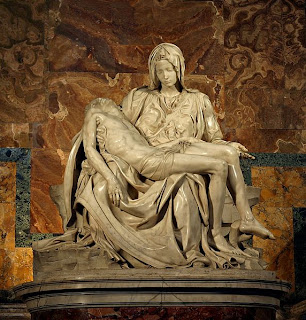Michelangelo's "Pietá," 1498/99-1500, Marble
The significance of this piece struck me while visiting the famous basilica in Rome. Hidden behind a crowd of art-hungry tourists, the statue remained so peacefully contained in a glass case with a spotlight highlighting it's creamy hue. The sculpture has remained remarkable to me for varied reasons. First, the presence of the sculpture is overwhelming. Regardless of the chaos that flooded the basilica, Michelangelo's sculpture emanated grace and calmness. Most assumably, Michelangelo was attempting to convey the glory of Jesus' death as he unifies humanity and himself with God. Secondly, the image of Mary is remarkable. Not only is she beautiful, but she is also young, angelic, and powerful--most assuredly meant to express her irrevocable purity. Composing Jesus upon her knees provides a triangular structure that's pleasing to the eye. Thirdly, this being his second influential piece sculpted at the age of 23--the first being Bacchus at the age of 19--proves his tremendous talent and stature as one of the greats. In both its detail and precedence, Michelangelo's Pietá takes its place in the history books.

No comments:
Post a Comment